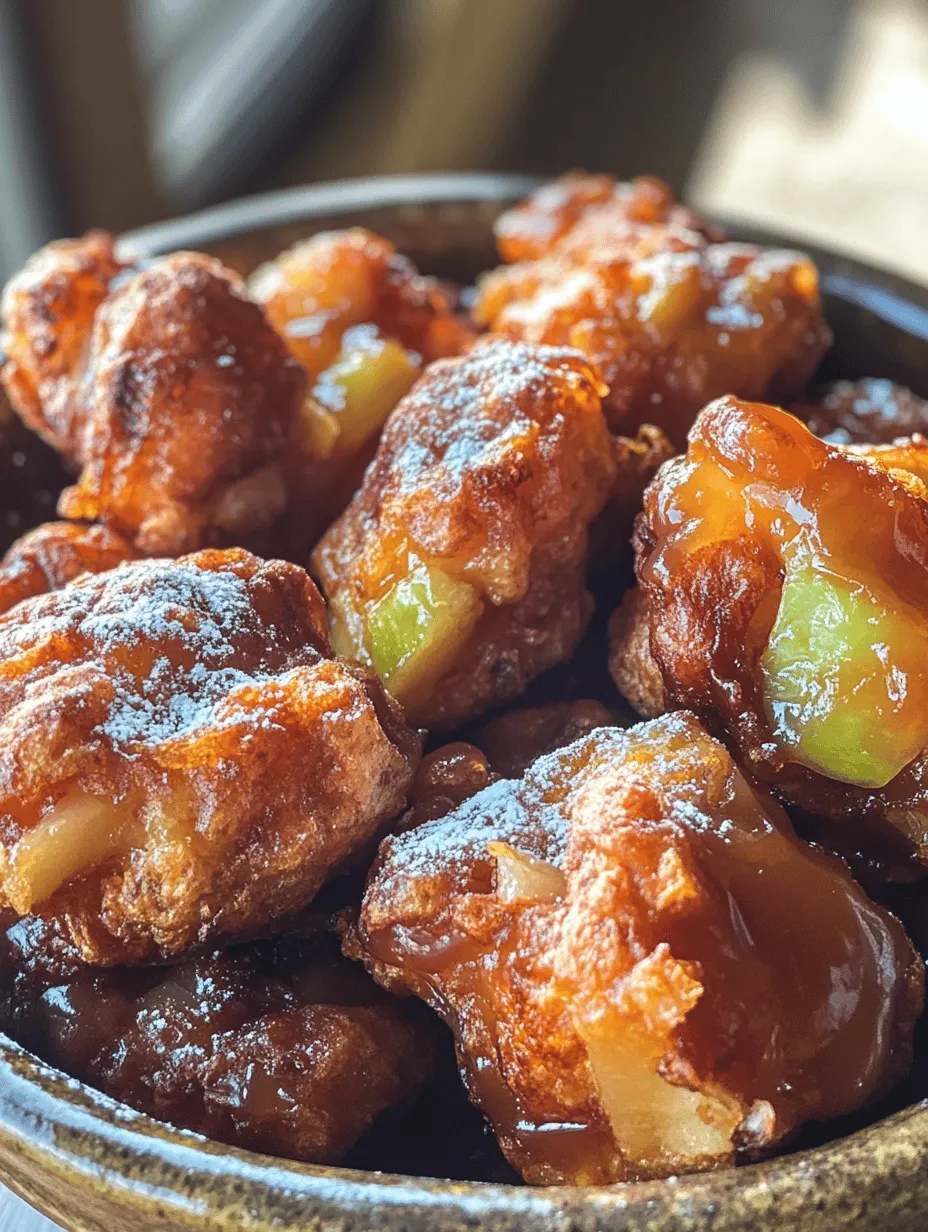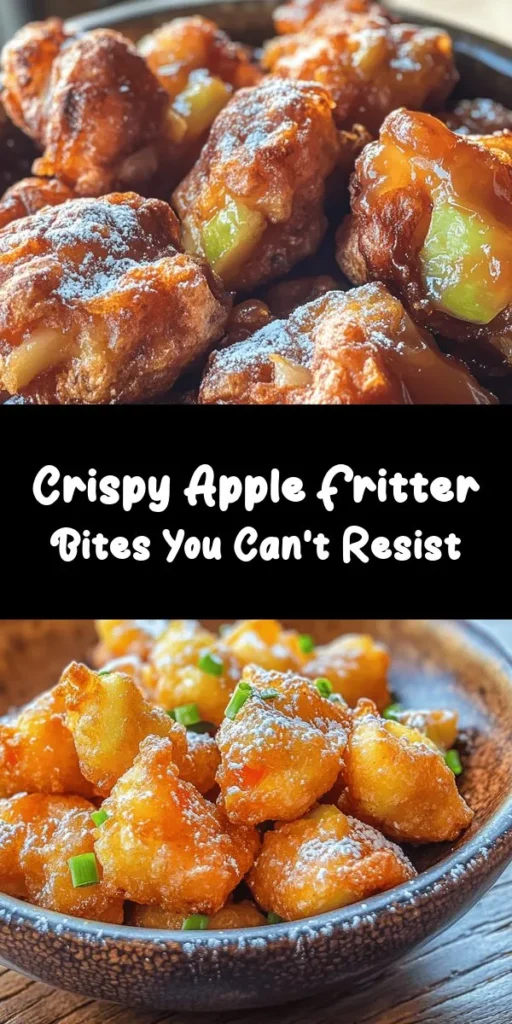Introduction
Apple desserts have a timeless appeal that resonates with food lovers across generations. From classic apple pies to warm, comforting apple crisps, the versatility of apples in sweet dishes is unparalleled. Among these delightful treats, apple fritters hold a special place in the hearts of many. These indulgent morsels, often dusted with powdered sugar and filled with warm, spiced apples, are a staple at fairs, bakeries, and brunch tables alike.
Apple Fritter Bites take this beloved concept and transform it into a fun, bite-sized version that is perfect for sharing—or sneaking a few for yourself! These little fritters pack all the deliciousness of traditional apple fritters but are easier to manage and enjoy in one or two bites. With a light, airy texture and a sweet, cinnamon-kissed apple filling, they are sure to become a favorite in your recipe collection.
To achieve the best results with your Apple Fritter Bites, it’s essential to use fresh, high-quality ingredients and follow some simple techniques. By doing so, you can create a batch of fritters that are not only scrumptious but also visually appealing, making them a perfect treat for any occasion.
Understanding the Ingredients
The key to delicious Apple Fritter Bites lies in the ingredients you choose. Each component contributes to the overall taste and texture of the fritters, so understanding their roles is crucial.
Apples
When it comes to selecting apples for frying, two varieties stand out: Granny Smith and Honeycrisp. Granny Smith apples are tart and crisp, providing a perfect contrast to the sweetness of the batter. Their firm texture holds up well during frying, ensuring that the apple pieces stay intact. On the other hand, Honeycrisp apples are known for their exceptional sweetness and juiciness, which adds a lovely flavor dimension to the fritters. Combining these two varieties can create a balanced flavor profile that is both sweet and tart, making every bite a delightful experience.
Flour
All-purpose flour serves as the foundation for your fritter batter, contributing to its overall structure and texture. The right amount of flour ensures that the fritters are not too dense or too airy. For this recipe, using high-quality all-purpose flour will help achieve the perfect balance, allowing your fritters to fry up beautifully and hold their shape while also providing a tender crumb.
Sweeteners
The choice of sweetener can greatly affect the taste of your fritters. While granulated sugar is the traditional option, you can also experiment with alternatives such as coconut sugar or maple syrup for a unique flavor twist. Granulated sugar provides a classic sweetness, while alternatives can add depth and a hint of caramel flavor. It’s essential to consider the sweetness of the apples you are using, adjusting the amount of added sugar accordingly.
Spices
Cinnamon and nutmeg are the stars of the show when it comes to flavoring your Apple Fritter Bites. These warm spices enhance the sweetness of the apples and add an inviting aroma that makes your kitchen feel like fall, regardless of the season. A sprinkle of cinnamon can be mixed into the batter, while nutmeg can be added for an extra layer of flavor. The right balance of spices will elevate your fritters from good to unforgettable.
The Significance of Wet Ingredients
Wet ingredients like milk, eggs, and vanilla extract play a crucial role in binding the batter together and adding moisture. Eggs provide structure and richness, while milk contributes to a tender texture. A splash of vanilla extract enhances the overall flavor, making your fritters even more delightful. It’s important to measure these ingredients accurately to ensure the correct batter consistency.
Oil for Frying
The type of oil you choose for frying can significantly impact the final product. Canola oil and vegetable oil are recommended due to their neutral flavors and high smoke points, allowing for even frying without imparting any unwanted tastes. Properly heating the oil is essential for achieving that golden-brown exterior and perfectly cooked interior for your fritters.
Preparing the Apple Fritter Bites
Now that you understand the importance of each ingredient, it’s time to dive into the preparation process. Follow these step-by-step instructions to create your Apple Fritter Bites.
Step 1: Preparing the Apples
The first step in making Apple Fritter Bites is preparing the apples. Start by peeling your chosen apples—Granny Smith and Honeycrisp are great options. Use a sharp peeler to remove the skin, taking care to maintain the flesh intact. Once peeled, core the apples and chop them into small, bite-sized pieces. Aim for uniformity in size to ensure even cooking.
For an extra flavor boost, consider tossing the chopped apples with a sprinkle of cinnamon before adding them to the batter. This simple step enhances their flavor and infuses the fritters with warmth and spice.
Step 2: Crafting the Batter
With your apples prepared, it’s time to make the batter. Begin by mixing the dry ingredients in a large bowl. This typically includes all-purpose flour, baking powder, granulated sugar, and a pinch of salt. Whisk these ingredients together until they are evenly combined, which will help prevent clumping and ensure a consistent texture in your fritter bites.
Next, gather your wet ingredients in a separate bowl. This includes eggs, milk, and vanilla extract. Whisk them together until fully combined. It’s critical to avoid over-mixing at this stage; you want just enough blending to incorporate the wet ingredients into the dry ones. Over-mixing can lead to a dense batter, which is not ideal for fritters.
Once the wet and dry ingredients are combined, gently fold in the prepared apple pieces. Use a rubber spatula or wooden spoon to carefully mix the apple chunks into the batter, ensuring they are evenly distributed. Be cautious not to overwork the batter; a few lumps are perfectly fine and will contribute to a light, fluffy texture.
Step 3: Mastering the Frying Process
With your batter ready, it’s time to heat the oil for frying. In a deep, heavy-bottomed pot or a deep fryer, pour enough oil to submerge the fritters (about 2-3 inches deep). Heat the oil to around 350°F (175°C). A cooking thermometer can be a valuable tool here, ensuring you achieve the right temperature for frying. If you don’t have a thermometer, you can test the oil by dropping in a small spoonful of batter; if it sizzles and rises to the surface, the oil is ready.
When frying, safety is paramount. Avoid overcrowding the pot, which can lower the oil temperature and result in greasy fritters. Instead, fry in small batches, allowing each fritter bite enough space to bubble and cook evenly. As you fry, keep an eye on the color; the fritters should turn a beautiful golden brown.
Safety Precautions
Frying can be hazardous, so it’s important to take some safety precautions. Ensure that your workspace is clear of any flammable materials, and keep a close eye on the oil temperature to prevent overheating. Use a slotted spoon or spider to carefully remove the fritters from the oil, allowing excess oil to drain before transferring them to a paper towel-lined plate. This will help keep your fritters light and crisp.
By following these initial steps, you’ll be well on your way to creating irresistible Apple Fritter Bites that are sure to impress. The combination of fresh apples, fragrant spices, and a perfectly fried batter will result in a treat that’s both comforting and indulgent. Stay tuned for the next part of this article, where we will explore the finishing touches and serving suggestions for your delicious fritters!

Methods to Check Oil Temperature for Perfect Frying Results
Achieving the ideal oil temperature is crucial for frying Apple Fritter Bites. The perfect frying temperature typically ranges from 350°F to 375°F (175°C to 190°C). If the oil is too cool, the fritters will absorb excess oil and become greasy. If it’s too hot, they may brown too quickly on the outside while remaining raw inside.
To check the oil temperature without a thermometer, you can use a few simple methods:
1. Wooden Spoon Test: Dip the end of a wooden spoon into the oil. If bubbles form around the spoon, the oil is ready. If the bubbles are vigorous, the oil is too hot.
2. Popcorn Test: Drop a kernel of popcorn into the oil. If it pops, the oil is around 350°F, ideal for frying.
3. Bread Cube Test: Drop a small cube of bread into the oil. If it browns in about 60 seconds, the oil is at the right temperature.
Frying the Fritter Bites
Once the oil reaches the desired temperature, it’s time to fry the fritter bites. Here’s how to do it effectively:
1. Best Practices for Portioning the Batter: Use a small cookie scoop or two spoons to portion the batter into the hot oil. This ensures uniformity in size, allowing for even cooking. Each fritter should be about 1-2 tablespoons in size.
2. How to Determine When the Fritters Are Perfectly Cooked: Keep a close eye on the fritters during frying. They should take approximately 2-4 minutes per side to achieve a beautiful golden brown color. Use a slotted spoon or tongs to gently flip the fritters halfway through cooking to ensure an even fry.
3. Tips for Avoiding Overcrowding the Frying Vessel: Overcrowding can lead to temperature drops in the oil, resulting in soggy fritters. Fry them in small batches, allowing enough space between each fritter for the oil to circulate. This not only ensures they fry evenly but also helps them maintain their crispy texture.
Finishing Touches: Draining and Dusting
After frying, the fritters need proper care to enhance their taste and texture.
1. Techniques for Draining Excess Oil: Once the fritters are golden brown, remove them from the oil using a slotted spoon. Place them on a plate lined with paper towels. This will help absorb any excess oil, ensuring a less greasy final product.
2. Importance of Using Paper Towels and Slotted Spoons: Paper towels are essential for draining, while slotted spoons allow excess oil to drip off effectively. Avoid using regular plates, as they may trap oil and moisture, resulting in soggy fritters.
3. Dusting with Powdered Sugar: While the fritters are still warm, dust them generously with powdered sugar. The warmth of the fritters allows the sugar to adhere better, creating a delightful sweetness that complements the apple flavor perfectly.
4. Suggestions for Additional Toppings: For those looking to elevate the experience, consider drizzling the fritters with caramel sauce or serving them alongside a scoop of vanilla ice cream. These additions can transform your fritter bites into an indulgent dessert.
Serving Suggestions
Apple Fritter Bites can be enjoyed in various delightful ways.
1. Creative Ideas for Serving: For a charming presentation, arrange the fritter bites on a decorative platter. You can garnish them with fresh apple slices or even a sprinkle of cinnamon for an extra touch.
2. Pairing with Beverages: These fritters pair beautifully with warm beverages like coffee, spiced tea, or apple cider. The warmth of the drinks complements the warm fritters, creating a cozy atmosphere.
3. Presentation Tips for a Delightful Dessert Display: Use a tiered cake stand to display your fritter bites attractively. This not only elevates the presentation but also makes it easy for guests to serve themselves.
4. Versatile Serving Options: Apple Fritter Bites are perfect for brunch or dessert tables. They can be served as part of a larger spread of pastries, fruits, and cheeses, allowing guests to mix and match flavors.
Nutritional Information and Benefits
While Apple Fritter Bites are a delightful treat, it’s good to be aware of their nutritional profile:
1. Overview of the Nutritional Profile: A typical fritter bite contains about 150-200 calories, depending on the size and amount of sugar used. They provide carbohydrates from the batter and natural sweetness from the apples.
2. Discussion on the Balance of Flavors and Textures: The combination of the crispy exterior and soft, warm apple filling creates a satisfying contrast. The added sweetness from the sugar enhances the natural flavors of the apples, making each bite a delicious experience.
3. Healthier Alternatives for Those Looking to Modify the Recipe: For those seeking a healthier option, consider substituting all-purpose flour with whole wheat flour or using alternative sweeteners like honey or maple syrup. You can also bake the fritters instead of frying them for a lighter version, though this will change the texture slightly.
Conclusion
Making and sharing homemade Apple Fritter Bites is a joyful experience that brings friends and family together. The process of frying these delightful treats fills your kitchen with the warm aroma of cinnamon and apples, creating a cozy ambiance.
As you experiment with variations—perhaps adding nuts, different spices, or even glazes—you can create a personalized twist on this classic recipe. The satisfaction of enjoying warm, freshly made fritters with loved ones is a heartwarming experience that makes every bite worth it.
So gather your ingredients, check your oil temperature, and dive into the delightful world of Apple Fritter Bites. Whether you serve them for brunch, dessert, or a cozy evening snack, these little bites of heaven are bound to be a hit. Enjoy the process, cherish the moments shared, and indulge in the deliciousness that comes from your very own kitchen.



